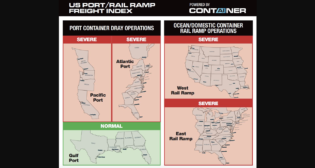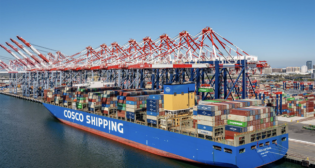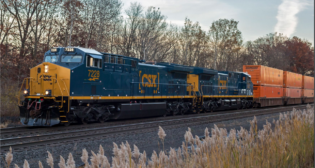
Turning on the intermodal tap
Written by William C. Vantuono, Editor-in-ChiefAbout 800 million gallons of water flow through Maine aquifers for the Poland Spring company each year. Since January 2016, containers full of that water flow south from Maine by rail.
It began as Portland, Me., renewed its once prosperous port, “and new rail development became part of this renewal,” says John Henshaw, Executive Director of the Maine Port Authority. “We can attract more business to our port, if we have more shipping options.”
“We were trying intermodal years ago, and it didn’t go as well as we’d like,” says David Bernhardt, a 33-year veteran of Maine’s Department of Transportation, and currently Commissioner. “But we believe the different players are cooperating better now, and this new Poland Spring project is a good example to illustrate intermodal opportunities.”
Eimskip, an Icelandic shipping company, began carrying containerized cargo between Portland and Europe in 2013. The Maine Department of Transportation had prioritized $40 million in state, federal and private funds to upgrade the International Marine Terminal (IMT), including the addition of 1,500 feet of track to connect with an existing Pan Am Railways main line nearby.
Poland Spring, one of Maine’s most iconic businesses, became the first to use the port’s intermodal rail option, including renting Eimskip containers.
“The rail option fit with our company’s interest in our environment,” says Christopher Haynes, Northeast Logistics Director for Nestle Waters North America, owner of Poland Spring. Commercialized since 1859 from the actual fresh water spring bearing the company’s name, Poland Spring exists in a water-rich area known since the times of Native Americans.
The company maintains three bottling plants in Maine: Poland Spring, Kingfield and Hollis, which is the largest bottled water facility in North America and second-biggest in the world.
“Getting all of our water west, south and north from Maine requires a lot of transportation,” says Haynes, who notes since the bottled water craze took off in the U.S. in the late 1990s, an increased number of trucks brought the product to market.
Reading about the development of Portland’s IMT, Haynes inquired about trial rail runs. “Poland Spring’s initiative, Haynes’ especially, really got this going, really opened our eyes to more of these possibilities,” Commissioner Bernhardt says.
Haynes’ trial runs proved successful in 2015, and in January 2016, Poland Spring began trucking palletized bottled water 20 miles from Hollis to the Portland IMT intermodal terminal. Some 45 containers are then loaded onto trains bound for Massachusetts three days a week: Friday, Saturday and Sunday.
In April 2016, Poland Spring expanded the initiative to bring an additional 60 containers by truck from Kingfield, Me., 45 miles to the Pan Am railyard in Waterville, Me., then by train 75 miles to Portland to join the train traveling south to Ayer, Mass. Here, trucks bring the pallets from the 105 weekly containers to area distributors.
“This arrangement between Poland Spring, the Maine Department of Transportation and Pan Am has proven successful,” says David Fink, President of Pan Am Railways. “It’s led us to discussions to expand south into New England and New York.”
In addition to the Ayer intermodal terminal, Pan Am, a Class II carrier, has built a new intermodal terminal in Mechanicville, N.Y., with its partner Norfolk Southern, westward along the upgraded Patriot Corridor. It hopes to attract Poland Spring and others to expand there with intermodal, enticed by rail’s generally lower transportation costs, since greater volume can be moved with less fuel and fewer workers.
“It makes sense for us to encourage more of these intermodal initiatives,” Fink says, “especially with companies such as Poland Spring that have environmental considerations as part of their branding.”
Haynes calculates that Poland Spring will move 4,600 containers from Maine by rail instead of trucks in 2016, a reduction of 500,000 road-miles and 5,400 metric tons of carbon emissions. The company estimates it’s the equivalent of removing 1,100 automobiles from the roads annually.
“People can see the congestion savings on the road,” says John Henshaw, explaining why the state is financially supporting rail projects like this through its Industrial Rail Access Program (IRAP), which grants up to 50% of estimated rail project costs. (Pan Am Railways received a $201,060 IRAP grant for this project in Waterville, which it then matched.) “Heavy trucks damage our roads. We’re hoping our IMT development here can get more of the large companies to move to rail, and make the transport costs competitive for them to do so.”
“We can’t continue expanding interstates; what are we going to do?” Bernhardt asks. “We like to say we are ‘mode-agnostic’ in the Department of Transportation. But if we can all work together to improve the rail mode, we’ll do our part to push it for the benefits of everyone, including the public.”
In the summer of 2016, the federal government’s FASTLANE program awarded Portland’s IMT a $7.7 million grant, to be matched with an additional $7.7 million from state and private funds. Henshaw explains the money will be used to increase rail capacity by adding railcar storage track, and additional siding tracks for loading purposes. Currently, 10 cars can be loaded here at a time, which will be doubled after this expansion. The IMT will also solicit a bid for a new Mi-Jack RailPacker. Next year, a cold storage facility will break ground at Portland’s IMT, opening further intermodal and market possibilities.
“The Poland Spring project has proven this rail component can work well,” Henshaw says. “We hope these next developments will show everyone how intermodal can work better for our future.”
This article originally appeared in the October 2016 issue of Railway Age.



